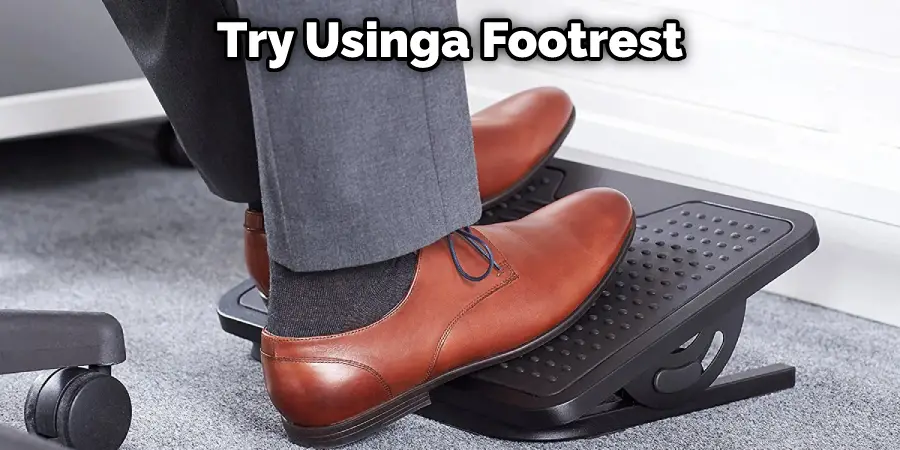Are you struggling with back pain that’s making it difficult to focus on your work? Has it helped your posture disappear since the pandemic started and left you in a less-than-ideal seated position for hours each day?

Sitting at home or in the office can cause strain on our backs, but by learning how to sit properly in an office chair, we can reduce our risk of back pain. In this blog post, I’ll be discussing how to sit in office chair to avoid back pain.
With so many of us spending more time sitting than ever before, setting ourselves up for success when it comes to avoiding aches and pains is incredibly important – read on for advice from experts about how to make sure you’re comfortable while doing your job!
What Is the Correct Way to Sit in an Office Chair?
The correct way to sit in an office chair is with your back against the backrest, feet flat on the floor and your hips slightly higher than your knees. The goal is to keep your spine in a neutral position while sitting, which can help prevent or relieve lower back pain.
When seated, you should adjust the height of the chair so that your feet are flat on the floor and your legs form a 90-degree angle at the knees. Your arms should be relaxed at either side of you and close to the body, not reaching forward or outstretched. Make sure there’s a small gap between the edge of the seat and the backs of your knees.

You should also adjust any armrests you have on your chair, if applicable. Armrests should be adjusted so that they support the arms when typing and using a mouse but do not restrict movement while doing so.
When sitting in an office chair, it’s important to remember to take frequent breaks throughout the day. Stand up, move around, and stretch out your muscles at least every 30 minutes if possible. This helps relieve pressure on your lower back and gives you a break from sitting in one position for too long.
By following these tips and sitting correctly in an office chair, you can reduce pain or discomfort associated with lower back issues due to prolonged periods of seated work. Make sure to check with your doctor if any medical concerns arise after implementing these tips.

10 Methods How to Sit in Office Chair to Avoid Back Pain
1. Use a Lumbar Support
If your office chair doesn’t have built-in lumbar support, you can use a small pillow or rolled-up towel to support your lower back. Simply place the pillow or towel in the small of your back and adjust it until you feel comfortable.
This will help keep your spine in its natural position and keep your back muscles from becoming overworked. However, if you find that lumbar support doesn’t help with your back pain or makes it worse, you should speak to your doctor or healthcare provider.

2. Sit up Straight
It’s important to sit up straight in your office chair to avoid putting unnecessary strain on your back. Be sure to keep your shoulders down and relaxed and your chin level with the ground. You may need to adjust your chair height or use a footrest to help you maintain good posture.
If you’re not sure what good posture looks like, consider investing in an ergonomic chair or office setup to help you out. Although it may take some time to get used to, the long-term benefits of having good posture while sitting in your office chair are well worth the effort.
3. Use a Footrest
If you find it difficult to keep your feet flat on the ground while sitting in your office chair, try using a footrest. A footrest will raise your feet off the ground and provide you with extra support. This can help to reduce back pain and tension in your legs and buttocks.
Experiment with different heights to determine the best placement for your feet. You may also consider using a footrest that is adjustable, so you can change its height as needed.
Finally, be sure to pay attention to your posture while sitting in your office chair and adjust the footrest accordingly. Doing this will ensure that you are properly supported and maintain a healthy posture.

4. Adjust Your Chair Height
One of the most important things you can do to avoid back pain while sitting in an office chair is to adjust the height of the chair so that your feet are flat on the ground and your thighs are parallel to the ground.
This will ensure that your spine is in its neutral position and reduce strain on your lower back. Additionally, you should make sure the armrests of the chair are at a comfortable height to support your arms while you are typing. If needed, add a footrest so that your feet can stay comfortably flat on the ground.
5. Adjust Your Chair’s Backrest
Another important thing to do is to adjust the backrest of your chair so that it supports your lower back. The backrest should be at a 90-degree angle to your spine, and you should be able to comfortably rest your head against it without straining your neck.
Make sure that the backrest is not too high or too low and can be easily adjusted so that it provides adequate support for your lower back. While you are seated, your lower back should maintain contact with the backrest of the chair. This will help you to keep a healthy posture and reduce the risk of developing back pain.
6. Take Frequent Breaks
Sitting in an office chair for long periods of time can put a strain on your back, so it’s important to take frequent breaks throughout the day. Get up and walk around for a few minutes every hour or so, and try to do some light stretching exercises every few hours as well.
This will help to reduce stiffness and relax your muscles, which can go a long way toward preventing back pain. Additionally, make sure that you’re getting up and taking a long break for lunch each day – don’t stay sitting in your chair right through it.
7. Avoid Slouching
Slouching in your office chair can put a strain on your spine and lead to back pain, so it’s important to sit up straight and avoid slouching as much as possible. Make sure that your feet are flat on the floor and that your shoulders are relaxed and not hunched or tensed.
You can also use a cushion to support your lower back, which can help you sit in a more upright position. Additionally, make sure to adjust the height of your office chair so that it’s at an appropriate level for your desk. This can help maintain a good posture.
8. Use Armrests Regularly
If your office chair has armrests, be sure to use them regularly throughout the day as they can help take some of the strain off of your shoulders and neck. Adjust the armrests so that they are at a comfortable height for you, and make sure they are close enough to the edge of the seat so that you can easily rest your arms on them when needed.
9. Avoid Reclining Too Far Back
Reclining too far back in your office chair can put unnecessary strain on your lower back, so it’s important to make sure you don’t overextend the recline feature of your chair.
Try to keep the angle of the backrest between 90 and 110 degrees when sitting in an upright position. This will help you have the best posture and keep your body in a comfortable position, which can reduce back pain.
10. Get a New Office Chair If Necessary
If none of the above measures are helping to reduce your back pain, it may be time to invest in a new office chair that is designed specifically to prevent or reduce back pain while sitting for long periods of time. Look for chairs with adjustable height, lumbar support, armrests, adjustable backrest angle, and a swivel base.
There are also ergonomic office chairs available that take into account the natural curves of your spine for additional comfort and support. A good office chair should provide plenty of support without being too stiff or uncomfortable, so make sure to try out a few different models before buying one to make sure it’s the right choice for you.
Conclusion
With a few simple adjustments, you can learn how to sit in an office chair to avoid back pain and stay comfortable for hours on end. So, don’t forget—get up, move around, stretch frequently and make sure you find an ergonomic chair that works preferably with regular check-ups by your health care professional.
How to Sit in Office Chair to Avoid Back Pain is an achievable goal as long as you are aware of maintaining proper posture!

